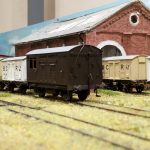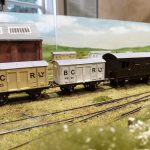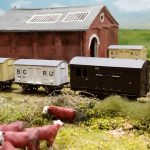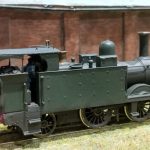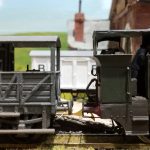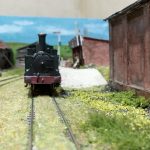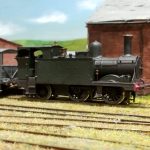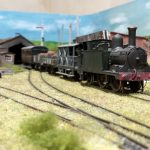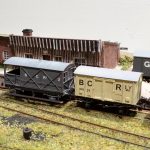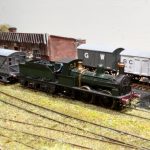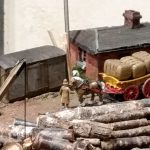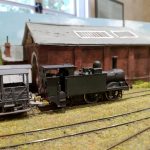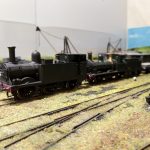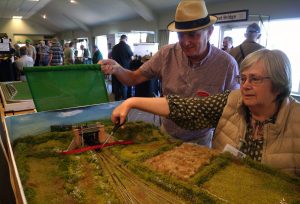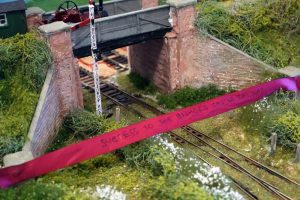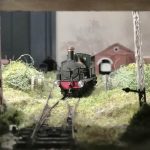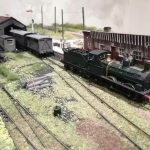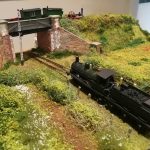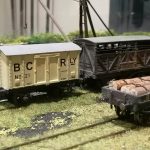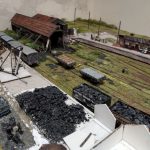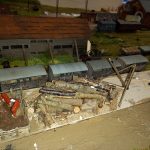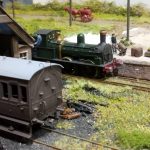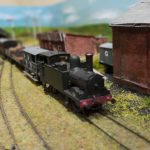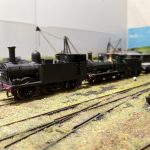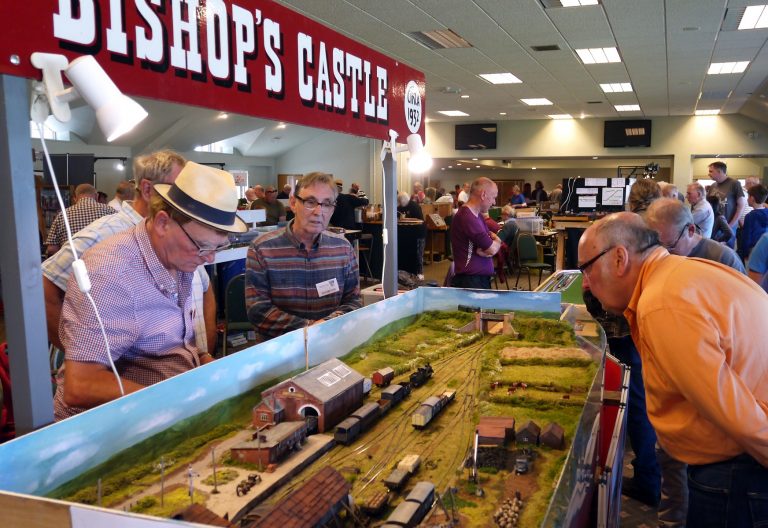
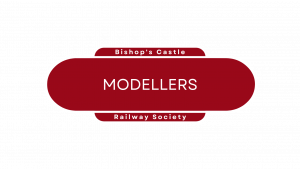
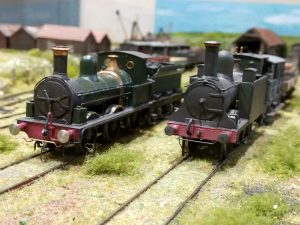
2024
Good progress continues to be made with various outstanding items on Bishop’s Castle c.1932. Stuart and his merry men have now added further couplings to nearly all of the existing rolling stock, as well as to the two locomotives which will make coupling and uncoupling very much easier. These additional Sprat and Winkle fittings are, when painted, very unobtrusive and operate by means of a tiny magnet (about the size of a tack head) hidden between the sleepers at various suitable locations on the layout. A couple of these have been installed and there are several more to be placed in situ.
David Hemsley has produced yet more items of freight stock – so that we now have examples of all four of the BCR covered wagons – they await weathering – along with a beautifully made Great Western horsebox.While the BCR didn’t own any of the latter sort of vehicles we have documentary evidence of them running on the line thanks to David Morgan’s journey from Craven Arms to Bishop’s Castle made in April 1934. Young Mr. Morgan recounts an army officer de-training two horses from a pair of horseboxes at Lydham Heath and riding off with them to wherever it was he was staying. This was probably Lydham Manor – the original house of this name – demolished in the 1960s. The building now so called was the former stable block, later converted into a large house using materials from the old mansion.
We are also awaiting the arrival of a further Private Owner coal wagon which is being produced as a limited edition by Shrewsbury Model Railway Club, the organisers of the show we are attending in June. This is an exact replica of one of the wagons which belonged to C.J.Hyslop of Church Stretton. While in the photograph it is numbered 12, it is not known how many such wagons Mr. Hyslop owned. Most small scale coal merchants usually had but one or two, although they often numbered them so as to suggest there were far more. The reason for this was that it looked better to appear to be in a greater way of business than was really the case!
I have been adding in several further figures to the layout. We now have a driver for the traction engine on the Love Lane bridge- although true to form for a British workman he is leaning against the brickwork there with a mug of tea in his hand. An ostler has also appeared to take charge of the hitherto “unsupervised” horse drawn water bowser. Such details go to make up the whole so that the end result is a model railway in a scenic setting which looks authentic. Obviously, these kinds of finishing touches take time to realise and are, for the most part, unobtrusive. I am also adding further buildings to the back scene behind the goods shed, including the instantly recognisable domed cupola of Bishop’s Castle town hall.
We have appealed several times in the past for further volunteers to come and help with the model but to date no-one else has come forward. It would be nice if some of you did, especially now that the modellers’ group has moved its modelling day to Tuesdays to coincide with the days on which the Weighbridge is normally open.
Jonathan Moor
2023
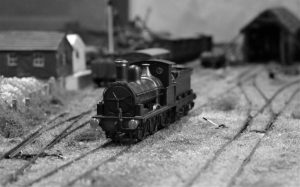
DECEMBER
During the last few months, further work has continued so as to ensure that Bishop’s Castle 1932 was ready for the special opening of the Weighbridge on Saturday 2nd December.
The most important news is that we now have on the layout working models of both Carlisle and Number 1 (Tankie) both of which have been built for us by Andy Jones, a member of the Society from Lewes in Sussex, and who is, by trade, a professional model maker. Those of us responsible for Bishop’s Castle c.1932 owe him an enormous debt of gratitude for all of his hard work. Neither of the kits of the two locomotives were straightforward to put together and would have defeated anyone not possessing Andy’s experience, patience, and indefatigability. The accompanying photographs show the excellent job he has done. The black and white photograph calls for comment. It is a staged recreation on the model of a photograph taken in 1930s with Carlisle and Number 1 posed together presumably for the benefit of a photographer with, behind the locomotives on the loading wharf siding, a coal wagon belonging to Gwilts who had set up the timber and coal yard on the station site back in the 1870s shortly after the opening of the railway.
Several people have commented on Number 1 not being in evidence, so a word on this is in order. Whilst we would all have liked to have had Number 1 operational a very long while ago, a major supplier let us down very badly with the on/off availability, then complete non availability, of the kit of the locomotive concerned and which is still not back in production. However, to make the layout as authentic as possible, along with Carlisle, it was imperative that we had a working model of Number 1 as, along with Carlisle, these two locomotives were the only ones working on the Bishop’s Castle Railway in the 1920s and 30s. Fortunately, Albyn Austin very kindly donated the necessary parts of an unmade kit and the result is as you see. Tankie was said to have ceased working in 1933 but there is documentary and photographic evidence of him very much in use as late as 1934 – before the well known photograph of the engine standing awaiting scrapping at Plowden in 1935.
We are now booked in to attend two model railway exhibitions next year – at Shrewsbury and Stafford – at which time both engines will definitely be running – which will enable us to present the layout (and thus the Society) to a very large audience indeed which is in part why the model was constructed in the first place. Further details of these exhibitions will follow in due course – one in June and the other in September 2024. Any help with transporting the layout to and from these venues and its exhibition at them will be most gratefully received. At Shrewsbury we have been allocated a stand for the Society as well – as we were at Ludlow – and once again help in running this will be needed.
Closer to home, Stuart and his merry band of helpers of David Etheridge and David Thornton have been hard at work improving the couplings on the rolling stock. This has involved fitting additional Sprat and Winkle fittings to some of the carriages and wagons so as to aid their coupling and uncoupling – assisted by “invisible” tiny magnets buried between the sleepers of the permanent way. It is a laborious process, but Stuart and co. have all to hand and are now so well versed in doing what is necessary that they could set up making these special couplings as a lucrative sideline! At the same time, Jonathan has been checking all the rolling stock to ensure that the wheels run freely in their bearings.
On the scenic front we were missing a defining structure adjoining the Weighbridge building – an old grounded van body which was situated more or less where the Banana Van now sits although in line with the building as opposed to standing at 90 degrees to it. David Hemsley has rectified this and the accompanying photograph shows this now in situ on the layout, thus making Bishop’s Castle c.1932 as accurate as possible in the space we have available to us.
Jonathan Moor
JUNE
CRAVEN ARMS AND DISTRICT MODEL RAILWAY CIRCLE EXHIBITION
3rd JUNE 2023 LUDLOW RACECOURSE
At precisely 1530 hours, on the afternoon of Friday 2nd June, a well oiled military style operation swung into operation. Its objective? To safely transport by road the 4mm scale model Bishop’s Castle c.1932 from its usual home in the Weighbridge over to the Hospitality Lounge of Ludlow Racecourse where the model railway exhibition, organised by Craven Arms and District Model Railway Circle, and which we had been permitted to attend, was to take place.
First of all the layout had to be separated into its two main sections – a task deftly undertaken by David Hemsley and a new recruit to the modellers’ group, David Thornton, who has turned his hand (he does in fact have two) to all manner of jobs, and which, thanks to Roger Dalton’s superb woodworking skills employed earlier in the construction of the baseboards, was accomplished very easily. Then came the tricky part – turning the two main parts of the layout onto their sides in order to move them outside.
Earlier, on Friday morning, Jonathan had checked and rechecked that everything on the layout – including the hare and the rabbits – was securely fixed before removing all of the rolling stock and the handful of items deliberately left loose. However, it was still with considerable trepidation that he watched as the layout – representing some two years’ hard work – was turned slowly onto its side. Would all of the buildings, the sheep, the Hereford cattle, the cow parsley, let alone the sparrowhawk on the goods shed roof stay in position? Or would they, in a scene akin to one in the film Titanic where, with the pitch of the sinking liner steadily increasing, all manner of fixtures and fittings break free plunging towards the bow – in this case crashing down onto the floor of the Weighbridge? Fortunately not a single item came loose and the respective parts of the model were moved through the Weighbridge and so outside. It has to be said that there, bathed in the sunlight of a glorious June afternoon, the layout looked spectacular.
Thereafter, the two main components of the model along with the traverser were duly loaded into David Hemsley’s pantechnicon. Actually it’s a van, but pantechnicon is rather more appropriate as the vehicle resembled nothing short of Dr. Who’s Tardis; in that it proved capable of accommodating all the other paraphernalia associated with the layout. This was because, in addition to the baseboards and traverser, there were to be loaded in the posts and the splendid name board with its white black shaded lettering on a maroon background crafted by Malcolm Reeves, along with one of the three trestles on which the layout rests when assembled. Stuart Taylor brought with him over to Ludlow the other two trestles to which he had fixed the lengths of square drain pipe into which the posts of the name board slot, David Thornton the spotlights, and Jonathan all of the loose items.
The journey to Ludlow was accomplished without mishap and in a far quicker time than it took to travel by train from Bishop’s Castle to Craven Arms – even with David H proceeding along at a stately pace on account of his precious cargo!
Once at the Racecourse, inside the exhibition hall, the layout was then quickly reassembled. The end result can be seen in the accompanying photographs – a real credit to everyone involved who, over the past two years, had given so freely of their time and expertise to turn what began as an off the cuff suggestion into the reality now standing there before us. I think everyone involved with creating Bishop’s Castle c.1932 felt not only a real sense of achievement and satisfaction but also a much entitled glow of pride. However, the real test would come on the morrow, the day of the exhibition.
And so, on the morrow, here we all were, reassembled together on the morning of the exhibition. Thanks must be extended to the members of the Craven Arms and District Model Railway Circle for organising the show which was very well attended, with several fine railway layouts present, in a variety of scales, and with excellent trade support.
But what of Bishop’s Castle c.1932?
Three words sum up its reception at the Ludlow Show which I have used as the title of this piece:
A Stunning Success
With the Honourable Mrs. Lin Dalton having most graciously performed the opening ceremony – see the attached photograph – by cutting a piece of suitably inscribed ribbon affixed across the Love Lane bridge, the members of the BCRSMG were under starters orders and then, having posed for photographs for the reporter from the Shropshire Star, with the public being admitted to the show, we were off.
The plaudits were not long in coming and, without any conceit, were numerous – whether on the locomotives – in particular Carlisle – the other rolling stock, the “weed grown” condition of the track, the appearance of the decaying buildings, the scenery and so forth; all of which one visitor said together engendered a wonderful evocation of the infinitely remote, rundown terminus of the Bishop’s Castle Railway in its twilight years. I am not sure of the number of visitors, but there were always people looking at the BCRS layout, taking photographs, and usually asking questions.
Those of us there were in due course joined by David Etheridge who had hot footed it all the way back from Anglesey to help us operate the layout. Time never stood still – even if the trains did – this occasioned by problems coupling and uncoupling the scale screw and 3-link couplings, to which there is a definite knack. Nonetheless, the BCR was never known for its speed of operation, so the resulting delays merely added to the authenticity of the scene being presented. There was also an electrical short circuit on the goods shed siding which is still under investigation by Stuart “Sparky” Taylor but which did not, per se, affect the operation of the layout.
All too soon it was time to run the last train and then dismantle the layout, load it again into David H’s capacious pantechnicon, and return everything back to the Weighbridge. In the coming weeks, the modellers’ group will have reconvened at the Weighbridge to discuss the exhibition, what went well and what did not, as well as planning future projects.
So, in conclusion, to everyone in the BCRS who over the past couple of years have helped to bring Bishop’s Castle c.1932 into being, my heartfelt and sincere thanks.
Jonathan Moor
MAY
With the Ludlow Model Railway Show now less than a month away, work on Bishop’s Castle c.1932 is almost complete, the modelling group having stepped up their activities so as to complete various outstanding tasks. That said, there always remains something to do, and no model railway layout can ever be said to be finished.
As you will have been seen from the previous Newsletter, the layout has been split into its two main parts along Shropshire’s very own San Andreas Fault. At this location David Hemsley has done a superb job of completing, at speed, all of the necessary electrical work to enable the layout to function, and which also means that the layout is so much easier to transport. He is presently hard at work laying the track on the traverser and wiring that up too.
Assisted by David Etheridge, Stuart is continuing making live the electrical connections at the terminus end of the layout. Jonathan has been finishing off various scenic items, including the second part of the back scene (the countryside), the Love Lane bridge, and the station approach, while at long last all of the buildings, including the station, platform, and goods shed, have been bedded in. Roger Dalton has continued employing his excellent woodworking skills and produced two posts on which the layout name board will be mounted.
What we now require from all of you is to come along to the Ludlow Model Railway Show, bringing with you your family and friends in order to see Bishop’s Castle c.1932 in action on its first trip away from the Weighbridge, resplendent beneath the superb name board painted for us by Malcolm Reeves.
So, after some two years of hard work, the 4mm model of Bishop’s Castle station is now nearing completion, but, in all likelihood, that is not to be the end of the story. Serious consideration is being given to an extension that will take the model down the line to Lydham Heath. This being so, more volunteers are very welcome to come and join the modelling group in order to help bring this to pass. Then there is Eaton, Plowden … Malcolm, I think you’ll need to paint us another sign!
My sincere thanks to the Directors of the Society for voting the modelling group the necessary funds to bring the model into being – I hope we have done justice to your vision – to all who have helped on the model to date, and to David Hemsley for the latest photographs.
Jonathan Moor
APRIL
Terraforming continues at pace, with the Bishop’s Castle landscape now recognisable from shed to Love Lane bridge. Almost all the landscape cover is now green and growing, with crops and livestock waiting to be discovered by visitors to the weighbridge. Most buildings are still to be bedded down and blended in, but this should be done by the start of June.
The signal post has sprouted at the nearly completed bridge, pointlessly guarding the exit from the station. Pointlessly, because as far as we know, it was never used for its proper purpose. It’s even more puzzling twin, in front of the engine shed, is also in place.
In preparation for the forthcoming Craven Arms MRC/Ludlow Racecourse exhibition (on Saturday 3 June, 10am to 4pm, see www.facebook.com/CADMRC/), with hearts in mouth we are splitting the layout for transportation.
At the moment it looks like we are modelling the San Andreas Fault, after it has revealed ancient catacombs left behind by some obsessively geometric alien civilisation, but all will be well once the track and connecting wires have been soldered in place and the scenery touched up and blended in.
David Hemsley
MARCH
The 4mm model of the terminus at Bishop’s Castle has continued to make significant progress as the photographs included in this article show. Various tasks remain to complete the layout in time for its first outing – to the Ludlow Model Railway Show on Saturday 3rd June.
David Hemsley has made up a further rake of superb freight stock, all appropriately and correctly lettered, enabling us to have sufficient cattle wagons to run a cattle special. While virtually all the trains on the Bishop’s Castle Railway (BCR) ran mixed, cattle specials were quite a feature of the line and were run in conjunction with the town fairs. The livestock on board usually comprised cattle and sheep. It is assumed most would have been going for slaughter – something which we don’t tell our younger visitors (and indeed some adults) Nonetheless, a good number of the animals would have been sold for onward movement to new owners/farms. At Christmastide (and presumably at other times too if the demand was there) the cattle wagons also carried geese. Thanks to David’s sterling endeavours we also now have the two brake vans which were likewise such a feature of the railway. Presently he is setting his sights slightly lower by making up the decrepit van body which stood alongside the weighbridge in a position at right angles to where the restored Banana Van now stands.
Stuart Taylor has been beavering away with the electrical side of things; ensuring that all of the points switch properly and that each of the various sidings are fully operational. There is nothing worse than taking a layout to an exhibition only to find that, because of insufficient attention to the electrics, there is a short circuit, a siding is found to be unaccountably “dead”, or locomotives stall repeatedly because the track is dirty or derail because it is misaligned. Roger Dalton is continuing preparing the two trestles on which the model will sit – at a slightly higher level than it does at present. Prior to this, Roger excelled himself with the production of a finely crafted traverser where the various items of rolling stock will be “marshalled” off scene. Away from the weighbridge, Malcolm Reeves is producing a sign to go above the layout so that it will be easily visible when out on tour at various shows.
Meanwhile, I’ve continued with detailing the landscape where the line runs out into the open countryside towards the Love Lane bridge. As the photographs show, this has included adding in all manner of vegetation, in particular, swathes of cow parsley which, since it is in flower May-June, sets the time of the layout.
Additionally, apart from the cattle and sheep, various wild animals have now appeared in plausible positions on the layout – most of which are to be found on this section of the model. While they are aimed at younger visitors to the Weighbridge and exhibitions, we have already had adults trying to spot the fox, let alone the station cat, a sparrow hawk, a hedgehog, badgers, rabbits, stoats, and a solitary hare. Given the fact that the layout is 4mm in scale, you will appreciate that some of these animals are very small indeed.
The intention has been to create a model of a railway running through a landscape as opposed to a toy train set and to make it as real as possible. In this regard, several visitors have given Bishop’s Castle c.1932 perhaps the highest accolade possible in the model railway world, by remarking that it is just like Pendon, (https://pendonmuseum.com) undoubtedly the finest 4mm model railway in the country, which is to be found at Long Wittenham in Oxfordshire. This being so, you will understand that we are indeed aiming high with Bishop’s Castle c.1932.
So, when the weather improves, if you still haven’t been along to see us (or indeed Pendon) then take a trip over to the Weighbridge, to the Ludlow Model Railway Show in June, or else down to Oxfordshire. Come to think of it, why not all three?
Jonathan Moor
FEBRUARY
The reason for the layout’s creation was not idle conceit but undertaken in order to help visitors to the Weighbridge understand exactly where the station and other vanished railway buildings were once situated. In other words to show what, standing in front of the Weighbridge on a long gone May morning in about 1932, a cooper having brought his load of barrels to the station, to convey them down to Craven Arms by train, would have seen.
A very great deal of time and effort has been invested in the model in order to try and make it as accurate as possible, bearing in mind that, save for the Weighbridge; all other railway buildings in Bishop’s Castle have long since passed into history. There still remain various items to complete on the model. Given the fact that another reason for its construction was to help make both the history of the Bishop’s Castle Railway and the Society known to a wider range of people, early on it was decided to make the layout portable. As a result, it has always been the intention to take the layout off to various model railway exhibitions. To this end, the layout is to make its debut at the Ludlow Model Railway Show on Saturday 3rd June 2023. The show held at Ludlow Racecourse – is presented by the Craven Arms and District Model Railway Circle (CADMRC), which was formed in the 1970s. CADMRC have their own fine 4mm railway layout, in their case of Craven Arms and Stokesay station as it looked in the 1920s and 1930s – the very same period as the model being built by our own Society members.
We need all the support we can muster, so please make a note for your diaries to come along to Ludlow Model Railway Show on Saturday 3rd June and cheer us on – literally if you wish – as Carlisle once again steams out of Bishop’s Castle station bound for Lydham Heath and then all stations down the Onny valley to Craven Arms and the wider world.
Additionally, Bishop’s Castle c.1932 is also booked in, presently as a reserve layout, for the Stafford Model Railway Show to be held at the Stafford County Showground over the week-end of 23rd-24th September. While we await confirmation for 2023, we are definitely part of the line-up of layouts for the Stafford Show in 2024. So, once again, please, another date for your diaries.
With the Ludlow Show looming, an article on the Society’s layout has been submitted to the editorial board of the Railway Modeller for consideration and, if accepted, to be included in one of their forthcoming issues – hopefully, that for May. We presently await hearing from the editorial board.
Jonathan Moor
END OF 2022
The 4mm scale model of Bishop’s Castle railway station continues to make further progress towards the Love Lane Bridge – situated at the far right of the layout when viewed from the front. This will form a scenic break where the model runs off onto a traverser/fiddle yard. For those of you unfamiliar with model railway nomenclature, this is the area where the locomotives and rolling stock are moved/shunted about “offstage” before running back onto a layout. Having expertly crafted the wooden boxes for the point switches, Roger Dalton is about to make a start on the framework for the traverser/fiddle yard. Over the layout, there will be a sign – painted by Malcolm Reeves – BISHOP’S CASTLE c.1932 – to match the replica of the station sign. This will make the layout’s presence very visible at model railway shows and, when in the Weighbridge, inform visitors what it is they are looking at. No offence intended, but some people really do have to be led by the hand! Either side of the layout will be two panels, illustrated with photographs, one telling a brief history of the railway, along with another explaining how and why the model came to be built. It is fair to say that, as it has progressed, the layout has attracted considerable praise, both from members and from visitors alike.
Most of the buildings and the scenery are now complete, although – as is often the case with a model railway – there are various details still to be added. For example, a flock (is that the collective noun?) of pigeon baskets has appeared on the platform in front of the station building, along with (in the yard) the first four (of eight) dummy point levers, and the embankment leading onto the Love Lane bridge is under construction. When complete, there will be a road menders’ scene sited here, incorporating a traction engine, living van, and water cart, complete with water pipes and 1930s road signs. The article in the previous Newsletter regarding the lorries operated by the Beddoes family came at a very opportune moment as on the layout there is now an elderly lorry loaded with coal sacks and three coalmen bagging up beside it – just along from where the collection of coal merchants’ huts are to be situated. In this area, more work is needed on the two Scotch derricks and also a grounded van body needs to be positioned alongside the weighbridge. That building needs to be bedded into position now that Roger (an exacting taskmaster!) has pronounced himself completely satisfied with its location. In front of the model of the building, and in the position it occupies in reality, is a scale etch of the weighbridge plate, beautifully produced for us by Geoff Kent from a photograph of the original.
Along with yet more freight stock (including two superb BCR brakevans built by David Hemsley) two carriages are now operational – these being Great Western four wheelers, the originals of which were hired in as and when needed by the BCR for excursion traffic in the 1930s since by this date only one of their own coaches (the ex-London and South Western six wheeler) was serviceable. David has a model of this to assemble after he has completed detailing the second Great Western coach. We will have sufficient cattle wagons to run a cattle special, as well as (when yet another Great Western carriage is bought and assembled) coaches to run an excursion train – whether one for visitors to and from the Shrewsbury Floral Fete or a Football Special from Craven Arms. The only problem is finding suitable half-witted looking 4mm passengers to sit inside the coaches as Craven Arms denizens! And, of course, we have sufficient other rolling stock to run the typical BCR mixed trains.
We are waiting to hear from Squires (a model railway firm down on the south coast) regarding the etches for Number 1 which, following the collapse of the previous supplier, are now back in production. At present we have completed, fully operational models of both Carlisle and a Great Western 2-4-0 Metro tank. It is believed that the latter ran on the line – although, admittedly, at an earlier period than when the layout is set (c.1932) most likely when one of the line’s two stalwarts was under repair and gives us a semi-legitimate reason to run what is a beautiful little model. Along with having done sterling work wiring up all of the pointwork on the layout, Stuart Taylor has spent a considerable amount of his time making the Metro tank run properly. It had been given to us, along with other 4mm model railway equipment, by a lady whose husband owned it and who, sadly, had passed away. Most of the collection was not suitable for the layout, but the Metro tank and the Allchin traction engine referred to above – now correctly repainted into prototypical livery – very much pass muster. Both will need lightly weathering to make them appear as they would have looked when “in service”.
As has always been the case, we are looking for more volunteers to come forward to help complete the layout and also, as and when it goes out on tour next year, to assist with transporting and operating it at various shows. So, if you want to help us, please get in touch with Stuart Taylor – satalt17@gmail.com Jonathan Moor
DECEMBER 2022
The model group have been hard at work to achieve their goal of `Carlisle` running with a rake of mixed rolling stock during the Christmas Open Day on December 3rd.
They are proud to say that the layout has been accepted as a reserve for the Stafford Show 2023 or definitely booked for 2024!
The attention to detail speaks for itself in these photographs. All photographs taken by member David Hemsley including the mono chrome version.
SEPTEMBER 2022
Members of the Society will, no doubt, have heard tell of the Beddoes family and their involvement with the Bishop’s Castle Railway. Yet, there is another family – the Crabbys – whom it is understood were just as prominent in the ancient market town during the 1920s and ’30s, even if they have left scant record of their presence. “Crabby by name and crabby by nature” was, it is believed, a phrase then current in Bishop’s Castle.
There were two spinster sisters – Miss Lynette Crabby – known as Lin – and Miss Nicolette Crabby – known as Nicky – along with a dashing, debonair, younger, bachelor brother, Captain David Crabby. Rumour has it that this military gent, possessed of a Walter Mitty disposition, spent most of his time propping up the bar in the tap room of The Three Tuns public house.
As can be seen from the model of the station, looking as it did c.1932, there are two seated female figures on the platform and inspection of the urinals at the rear will reveal, in a manner of speaking. a military gentleman. Do these figures represent the Crabbys? In the parlance of Private Eye, perhaps we should be told However, for the avoidance of any doubt, and indeed legal action(s), that the three Crabbys bore Christian names almost the same as those of two of the present Directors and one of their spouses is purely coincidental!
On a more serious note, given the fact that the conveyance of cattle and sheep was big business for the railway, 4mm livestock has now arrived on the layout in force, in the guise of Hereford cattle and Shropshire sheep. Over forty animals in total, all of which have had to be painted individually by hand.
Jonathan Moor
AUGUST 2022
One of the questions most frequently asked by many visitors to the Weighbridge is:
“So, where was the station?”
Unfortunately, no amount of gesticulating vaguely in the direction of a group of decaying, derelict buildings (none of which ever had anything to do with the Bishop’s Castle Railway) really cuts the mustard. So, when a modellers’ group was formed about a year ago, it was suggested that a small operational railway layout be created to show visitors what the terminus here in Bishop’s Castle actually looked like. Because of constraints of space, it was quickly decided that this would be in 4mm scale (where a foot in measurement in real life is represented by 4mm). Two other decisions were also made: that the layout would be portable so that it could be taken to model railway shows around the country in order to help promote the Society to the wider world and that, again because of constraints of space, while the model would be as accurate as possible, the true length and width of the prototype would have to be compressed. It was also decided that the layout would be set towards the end of the railway’s life; so the layout is set c.1932.
In 4mm scale, models of both of the locomotives – Number 1 and Carlisle in kit form were available, along with freight wagons and coaching stock. There are also kits produced – for the signals for the terminus of which two are required. These will be non-operational – just as they were in reality. As to buildings and structures, there are no commercially available kits, so in order to produce an accurate model; these have had to be scratch built. Fortunately, the railway was very well photographed, especially in its last years, and this archive has been drawn upon heavily to enable construction of the station, the goods shed and so on.
To date, all the track has been laid and is presently being wired up, and the majority of the buildings have been constructed and installed on the layout, although there is much detailing work still to be done, along with creating a back scene and country section to ensure the railway is portrayed as it was running through the Shropshire landscape to the ancient market town of Bishop’s Castle.
Kits of both the locomotives have been ordered and while Number 1 is still awaited, it is a matter of a week or so away from being delivered. Carlisle has already been constructed for us by a professional model maker to whom the Society is very grateful. A good representation of freight wagons have been made from kits and also scratch built, and a coach – a model of the ex London and South Western 6 wheeler, which by 1932 was apparently the only coach in regular use, has been purchased and awaits being made up.
We are always looking for new volunteers to come along and join the friendly modellers’ group and help work on all aspects of the layout, including, once it is completed, operating it for visitors to the Weighbridge and, in due course, at model railway exhibitions throughout the country. Anyone interested in joining the modellers’ group should email Stuart Taylor -satalt17@gmail.com
